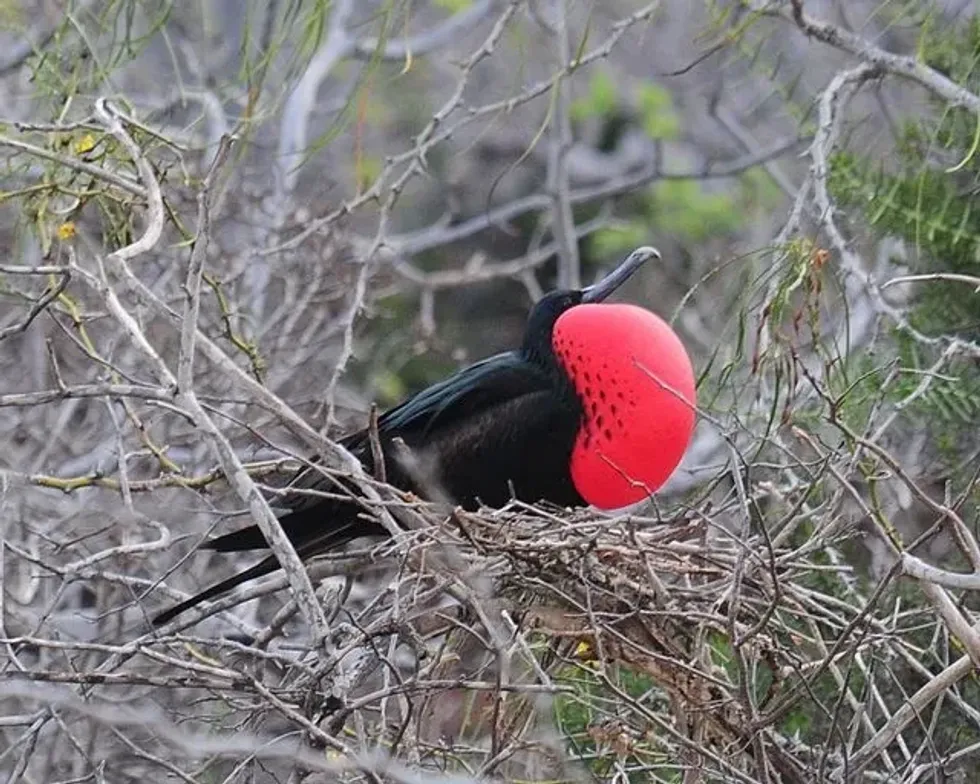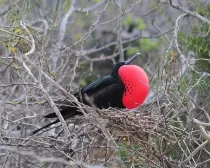Are you an avid bird lover and want to know more about the largest of the frigatebird species? Well, you don't need any bird guide, as we will provide all the information and fun facts about the magnificent frigatebird.
These animals are social creatures that live in large groups on land. Before they breed, these animals display courtship rituals.
This courtship ritual during the breeding season depicts the male enlarging its throat sac to its maximum size so as to attract the females.
These birds are food poachers as well as excellent fish hunters as they dive to the surface of the water to pick out fish. These are big birds and they have a giant wingspan of 84 in.
These birds are black to gray in color and have a beautiful deeply forked tail. La Frégate or a warship symbolizes this bird and its name was given by Jean-Baptiste du Tertre.
If you find this interesting then do check out the frigate and the golden pheasant.
Magnificent Frigatebird Interesting Facts
What type of animal is a magnificent frigatebird?
The magnificent frigatebird (Fregata magnificens) is a seabird and is also the largest bird of its species.
What class of animal does a magnificent frigatebird belong to?
The magnificent frigatebird (Fregata magnificens) belongs to the class of Aves of the Animalia kingdom.
How many magnificent frigatebirds are there in the world?
The magnificent frigatebirds, aka man o' war, are birds that are usually found in tropical and subtropical regions. Scientists and ornithologists are of the opinion that there are around 130,000 mature individuals of these birds on our planet.
The International Union for Conservation of Nature, or the IUCN, Red List has listed these birds as of Least Concern, i.e. these animals are not at all endangered, however, there has been a steady decline in their population owing to human activities like the destruction of habitat and climate change.
Where does a magnificent frigatebird live?
The magnificent frigatebirds are seabirds that can be found in abundance at the shorelines and coastal areas of the United States of America and Mexico. These tropical birds can be found in southern Florida, Brazil, the Caribbean Islands, and also along the coasts of Mexico and the Galapagos Islands.
What is a magnificent frigate bird's habitat?
The magnificent frigatebirds are a type of seabird and they are found in the tropical regions of North, Central, and South America. These birds are found predominantly along the shorelines of the ocean and the coastal areas.
These birds are known to build their nests near the shores and in coral reefs.
Other nesting places of these birds include small shrubs and trees that are found on islands. As far as feeding is concerned these birds are known to feed on their prey which they can find on the coastal shores and all along shallow lagoons.
Who do magnificent frigatebirds live with?
The magnificent frigatebirds are not solitary animals and can be found in groups. These big birds can gather themselves in large numbers in a very small area of land.
During the breeding season, these birds are known to form colonies that can contain up to 5,000 mature individuals. During other times of nesting, the strength of the colonies on the land is usually less and contains around 10-30 individual magnificent frigatebirds.
How long does a magnificent frigatebird live?
There is very limited data and information on the lifespan of the magnificent frigatebirds. However, according to the Cornell Lab of Ornithology, these birds can live up to 30 years in the wild.
In captivity, the average lifespan of these birds is around 14 years. The lifespan of these North American birds in the wild is extremely uncertain, as they are susceptible to a wide number of threats from habitat destruction, to poaching and climate change.
How do they reproduce?
The breeding process for the magnificent frigatebirds is special, however similar it is to a lot of birds. Their courtship ritual is frequent among almost all birds is also seen in these North American birds before they breed.
At the onset of the breeding season, the male magnificent frigatebirds depict the courtship ritual to attract a prospective female partner. The male magnificent frigatebirds inflate their gular sac like a balloon which is red in color.
These inflated gular sacs become so large that sometimes it covers the head of the bird. Apart from this, they also posture their body in such a way that they sit on their tails and start vibrating their wings at a very fast pace.
Apart from these displays, they produce a loud drumming sound to attract females. The females are known to inspect the males and then choose a partner.
These birds are monogamous and thus maintain a single definite partner for each breeding season.
However, the partner changes in the next breeding season. Once the partners are chosen they find the perfect nesting spot.
The determination of the bird reaching its sexual maturity is determined by its plumage. The males of these birds are known to mate every year while the females mate every other year, as the males don't take part in much parental activity.
Females are known to have a clutch size of a single egg which is laid almost a month after mating. The incubation period lasts almost 50 days.
As the hatchling starts to grow, both the parents take part in parental care, such as finding food for the young ones. At the onset of the 11th week after hatching, the males are known to leave the nesting spot, while the mother continues to take care of the hatchling.
What is their conservation status?
According to the International Union for Conservation of Nature or the IUCN Red List, the magnificent frigatebirds are listed as a species of Least Concern. This means that the animal is not under any threat of being endangered or even extinct.
However, owing to numerous human activities and natural calamities, the population of these North American birds has been constantly on the decline. Proper steps should be undertaken to protect the living and the sustainability of this bird.
Magnificent Frigatebird Fun Facts
What do magnificent frigatebird look like?

The most distinctive characteristic in these birds is the presence of a bright red gular sac, also known as a throat pouch, in the males. The females are devoid of this gular sac or the throat pouch.
These birds are colored in dark shades of black and brown while the females have a white-colored chest and markings on their wings. The legs and feet of the males are pink while those of the females are bluish-grey.
In these birds, the females are larger than their male counterparts.
These birds have very narrow wings which help them in generating more wing power and effective gliding over the oceans. These birds also have a narrow head and deeply forked tail which is distinctive from other common seabirds.
As these birds have significantly smaller legs they are not at all ideally suitable for swimming or waddling across the water. Thus these birds glide and hover all along the shorelines of the oceans and seas.
How cute are they?
The magnificent frigatebirds are extremely adorable birds and are thus considered cute by a lot of people. The male magnificent frigatebirds that fill up their throat sac for mating ritual makes them different and special from other species of birds.
How do they communicate?
There is very limited data and information regarding the means by how the magnificent frigatebirds communicate with one another. Generally, these birds prefer staying quiet and silent however vocal means of communication have been observed in many instances.
During the breeding season, the males are known to produce a large drumming sound to attract prospective females. These also make sounds and noises when they approach the nests or when they beg for food.
How big is a magnificent frigatebird?
The magnificent frigatebirds are large-sized birds and these birds are also considered the biggest birds of their species. In general, the magnificent frigatebird measure around 39.4-90.5 in (100-230 cm) in length and has a wingspan of 84 in.
The females are generally bigger in size than the males. In comparison to an average-sized seagull which is 15.7-18 in or (40-46 cm) in length, the magnificent frigatebird is almost twice the size.
How fast can a magnificent frigatebird fly?
The flight of frigatebirds is speedy. The speed of the flight magnificent frigatebirds is pretty fast in comparison to other birds as these birds can easily reach speeds of 30 mph near the ground when the wind speed is around 6-8 mph.
These birds glide and soar near the shorelines and are known to dive into the water to catch their prey.
How much does a magnificent frigatebird weigh?
The weight of the magnificent frigatebirds which are large-sized birds lies in the range of 3-4 lb (1.3-1.8 kg). In comparison to their size, these birds are pretty light in weight.
What are their male and female names of the species?
There is no specific name that has been ascribed to the male and female magnificent frigatebird. Thus the general way to refer to these birds is by calling them a male magnificent frigatebird and a female magnificent frigatebird.
What would you call a baby magnificent frigatebird?
Similar to all other birds, the baby magnificent frigatebird is known as a nestling or a chick.
What do they eat?
These birds are carnivores and their food consists of preying on squid, jellyfish, and other similar small fish and crustaceans. These birds also have an annoying habit where they chase other birds to make them drop their food and then ultimately steal their food.
These birds like seagulls and kingfishers are known to dive down to the surface of the water to catch fish.
Are they dangerous?
No, these birds are not at all dangerous. There are no instances of these birds attacking humans and there are there any proofs where humans are known to hunt these birds.
Would they make a good pet?
It would be unwise to keep these birds as pets for a number of reasons. First of all, these are wild birds and they prefer staying in their own habitat. Recreating a mangrove habitat or that of an ocean is impossible at home. These birds are great fliers and flies over oceans that can never be recreated anywhere.
Did you know...
Famous voyager Christopher Columbus is said to have encountered these birds in 1492 while he passing through the Cape Verde Islands.
Why do frigate birds puff up?
The males of these species are known to puff up their gular sacs during the breeding season. This falls under the mating ritual which is executed by the males to attract the females.
What is the red thing on a frigate bird?
The red thing that is present on the magnificent frigatebird is called a gular sac.
Here at Kidadl, we have carefully created lots of interesting family-friendly animal facts for everyone to discover! Learn more about some other birds including the house wren and the harpy eagle.
You can even occupy yourself at home by drawing one of our Magnificent Frigatebird coloring pages.









